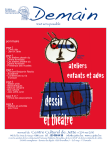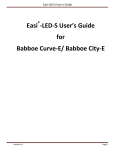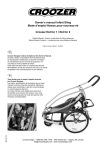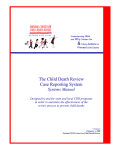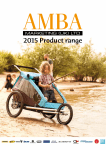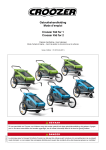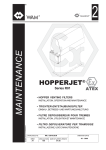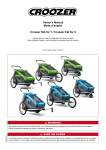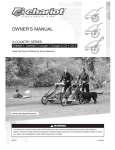Download Bambini On the Move with Bike and Kids
Transcript
On the Move with Bike and Kids A brochure full of information on safely cycling with your kids aged 0 to 6. Dear young parent, Do you like making bicycle excursions? Are you looking for advice on how to take your children with you? Do you want to bring your children to school by bike? Are you looking for the right solution? Then be sure to read on! This brochure is full of information on how you can safely cycle with your child(ren) aged 0 to 6. Children love being a bicycle passenger on excursions. So do not hesitate to take your children with you on bicycle trips! Discover all the possibilities on the market today, ranging from child bike seats and children’s bikes to bicycle child trailers and cargo bikes. Find out what you should pay attention to when buying a bicycle and get tips on road safety. Bad weather? The brochure offers solutions to that problem as well. This brochure is a great guide to a successful cycling experience with your little one(s). 2 On the Move with Bike and Kids Mobiel 21 vzw©, 2010 On the Move with Bike and Kids Inhoud General tips ............................................................................................................................................. 4 Babies on bikes. Is that possible? ........................................................................................................... 6 A child’s bike seat .................................................................................................................................... 9 The car seat on your bike rack .............................................................................................................. 14 The bicycle child trailer .......................................................................................................................... 17 The cargo bike ....................................................................................................................................... 23 A trail-a-bike .......................................................................................................................................... 28 Taking extra luggage or a buggy with you on the bike? ........................................................................ 31 Going out together by bike .................................................................................................................... 32 Bicycle helmet ....................................................................................................................................... 35 Your child’s development ...................................................................................................................... 36 Colophon ............................................................................................................................................... 38 Sources and useful links........................................................................................................................ 39 3 On the Move with Bike and Kids Mobiel 21 vzw©, 2010 On the Move with Bike and Kids GENERAL TIPS Before going into detail about the different systems, we will first give you a summary of some general tips and remarks that are relevant for all systems. Safety advice • Both you and your child(ren) should always wear a bicycle helmet. It provides extra safety. You can find more information on this topic in the chapter on bicycle helmets. Photo 1: Bicycle helmet • Make sure you and your child are clearly visible. You can improve your visibility by using a bicycle flag, wearing fluorescent jackets, decorating the bicycle (system) with fluorescent stickers and buying the system itself in a bright colour. • Adjust your style of driving. The extra weight will influence the way you steer, brake, start and it will limit your speed. Your bike might also be longer than you are used to. Bear this in mind when crossing a (busy) road. Also, empathise with your passengers: avoid rough and bumpy patches, adjust your speed, and avoid sudden steering or braking actions. • Provide your bike with double stands i.e. a tripod adjusted to both sides of your bike. The double stands will ensure your bicycle remains stable while you are taking your children in and out of the system. Photo 2: Bicycle with double stands • Make sure your own bike is safe before mounting an extra system. Do not put your saddle up too high so your feet can still touch the ground if necessary. Make sure you have good brakes and adjust your speed. • Regularly check if the attachment points are still secure. 4 On the Move with Bike and Kids Mobiel 21 vzw©, 2010 On the Move with Bike and Kids Purchasing tip To ensure good quality products and a personal customer service, purchase your equipment in a specialised bicycle shop. Online purchases might be cheaper but they do not guarantee the same quality and expertise you can find in specialised shops. Moreover, when you buy things online you will have to assemble the equipment yourself and you will have nowhere to go when something breaks or needs replacing. Visit your bicycle shop regularly to get your bike checked. Especially when buying second-hand equipment, a bicycle shop is the better choice. About branding This brochure only contains brands we are familiar with. If you know other brands and are satisfied about their quality, do not hesitate to tell us about it so we can add your advice to our brochure. You can find our contact information in the colophon at the back of the brochure. Belgian legislation According to the Belgian law it is obligatory to have a special seat on your bike when transporting a passenger by bike. If you do not have an adjusted bike, transporting a passenger is prohibited. 5 On the Move with Bike and Kids Mobiel 21 vzw©, 2010 On the Move with Bike and Kids BABIES ON BIKES. IS THAT POSSIBLE? The days in which you could not cycle with your children before their first birthday are long gone. Nowadays, there are systems that allow you to take your baby with you on your bike much sooner. Unfortunately, there are still many prejudices on this matter. Some say it is not safe for the baby because a bicycle jolts and shakes too much, increasing the risk of the shaken baby syndrome (SBS). We went in search of answers and found some reassuring solutions. What is the shaken baby syndrome (SBS)? Severely shaking a baby can cause brain damage, bleeding eyes, bone marrow and neck wounds and can even lead to death. These symptoms are what we call the shaken baby syndrome. The syndrome mainly occurs in cases of child abuse, when a baby is violently shaken in order to make it stop crying. Lightly shaking your baby, when for example waking it up, does not cause SBS. What are the causes? Babies have very weak neck muscles and a relatively large, heavy head. There is also space in between the brain and the skull so the brain has room to grow. When you severely shake a baby, the head and neck make a kind of whiplash movement; the head violently shakes back and forth and the brain moves about inside the skull as well. This phenomenon can cause the aforementioned symptoms. At what age? Under the age of 3 months, babies are still very vulnerable and their head and brain can easily be damaged. After 3 months, babies’ neck muscles are stronger and they are better protected against the risks of violent shaking. Once children are 1 year or older, it is very unlikely they will get SBS. A oneyear old has a different, more proportionate body than a baby: the head, chest and neck are more in balance. SBS and transporting a baby by bike In a car seat or baby hang mat or scale, the vibrations and limited shocks move in a head-to-feet direction and hardly occur in the opposite, front-to-back, direction. The vibrations are almost completely absorbed by the springs in the transport system. Thanks to this system, whiplash movements are completely eliminated. • Younger than 3 months Babies under the age of 3 months have no control over their neck muscles. Because of this, head-to-feat vibrations will always trigger front-to-back vibrations as well. However, when your baby is in a car seat, baby hang mat or baby scale adjusted to your bike, he/she will not experience any vibrations. Still, it is advised not to travel for over half an hour. The same holds true for travelling with babies by a car or in a pram. 6 On the Move with Bike and Kids Mobiel 21 vzw©, 2010 On the Move with Bike and Kids You should be extra careful when travelling with young babies. Make sure you have good springs and adjust your style of driving. Photo 3: An example of springs on a bicycle trailer • After 3 months As mentioned above, once babies are 3 months their neck muscles are more or less relaxed. Because of this, front-to-back vibrations no longer affect the baby and thus the SBS is unlikely to occur. However, it is still a good idea to bear the aforementioned adaptations in mind: good springs, a car seat, a baby hang mat or baby scale, an adjusted style of driving and short rides. Photo 4: A baby hang mat in a bicycle trailer Sources • • http://www.medicinenet.com/shaken_baby_syndrome/article.htm Medical (forensic) scientific articles, amongst others: - - Shaken baby syndrome. Blumenthal I. Postgrad Med J 2002 Dec; 78(926): 732-735. Shaken infant syndrome: developmental neuropathology, progressive cortical dysplasia and epilepsy. Marin-Padilla M., Parisi JE., Armstrong DL., Sargent SK., Kaplan JA. Acta neuropathology 2002 Apr; 103(4): 321-332. Neuropathology of inflicted head injury in children, I, Patterns of brain damage. Geddes JF., Hackshaw AK., Vowles GH., Nickols CD., Whitwell HL. Brain (2001), 124; 1290-1298. 7 On the Move with Bike and Kids Mobiel 21 vzw©, 2010 On the Move with Bike and Kids - - - Neuropathology of inflicted head injury in children, II, Microscopic brain injury in infants. Geddes JF., Vowles GH., Hackshaw AK., Nickols CD., Scott IS., Whitwell HL. Brain (2001), 124; 1299-1306. Traumatic axonal injury: practical issues for diagnosis in medicolegal cases. Geddes JF., Whitwell HL., Graham DI. Neuropathology and applied neurobiology (2000), 26; 105-116. Position paper on fatal abusive head injuries in infants and young children. Case EM, Graham MA, Handy TC, Jentzen JM, Monteleone JA and the National Association of medical Examiners ad hoc committee on shaken baby syndrome. Am J Forensic med Pathol 2001; 22: 112-122. The whiplash shaken infant syndrome: Has Caffey’s syndrome changed or have we changed his syndrome? Lazoritz S., Baldwin S., Kini N., Child Abuse Negl 1997 Oct; 21(10): 1009-1014. Anatomy of the shaken baby syndrome. Lancon JA., Haines DE., Parent AD. Anat Rec 1998 Feb; 253(1): 13-18. Retinal haemorrhages and child abuse Levin AV. Recent advances in paediatrics (David TJ, ed) vol 18. London, England: Churchill Livingstone; 2000: 151-219. Position statement on identifying the infant with nonaccidental central nervous system injury (the whiplash-shake syndrome). Luerssen TG, Bruce DA, Humphreys RP, the American society of pediatric neurosurgeons. Paediatric Neurosurg 1993; 19: 170. The spectrum of traumatic axonal injury T.A. Gennarelli Neuropathology and applied neurobiology 1996, 22, 509-513 The shaken baby syndrome. A clinical, pathological, and biomechanical study. Duhaime AC., Gennarelli TA., Thibault LE., Bruce DA., Margulies SS., Wiser R. J Neurosurg 1987 Mar ; 66(3) : 409-415. 8 On the Move with Bike and Kids Mobiel 21 vzw©, 2010 On the Move with Bike and Kids A CHILD’S BIKE SEAT A child’s bike seat is probably the oldest-known way of taking your child with you on your bike. The seats come in different shapes and sizes; they can be adjusted to your bike rack or steering wheel. But which seat is most suited for your child(ren)? What are the possibilities? • • • Rear-mounted child’s bike seats are suitable for children aged 1 and above Up to 15 kg (A15 or C15) or up to 22 kg (A22) Centre-mounted child’s bike seats, adjusted to the bike’s steering wheel Suitable for children aged 1 to 3 Up to 15 kg Centre-mounted child’s bike seats, adjusted in between the steering wheel and the driver Suitable for children aged 1 to 3 Up to 15 kg Photo 5: Rear-mounted child bike seat • • Steco Ukkie-Mee* Replace your steering wheel with one that already has a child’s saddle on it. It was specifically designed to give your child extra leg space. Suitable for children aged 1 and above Up to 15 kg Steco Pin-Up* This system allows you to shift back the bicycle saddle so you can create extra space between the child’s bike seat and yours. *Steco is the only brand we know that makes these kinds of child’s bike seats. If you know other brands, do not hesitate to tell us about it so we can add your advice to our brochure. You can find our contact information in the colophon at the back of the brochure. 9 On the Move with Bike and Kids Mobiel 21 vzw©, 2010 On the Move with Bike and Kids • The mother’s bike The mother’s bike guarantees a comfortable ride with two child’s bike seats. The bike is different from a regular city bike; it has more space between the saddle and the child’s saddle, it has double stands, it is easier to ascend, the frame is stronger and there are extra spokes that strengthen the wheels. These differences make it easier for parents to hop on and off their bikes and they offer more stability when securing your child in its seat. Photo 6: Parent bike with a centre-mounted child’s bike seat When is your child ready for a child bike seat? Parents are normally advised not to use a child’s bike seat before their child has turned 1. In order for the child’s saddle to be a safe and comfortable experience for your child, the latter should have a steady sitting balance. A child’s sitting balance is steady once it can independently move from a crawling position into an upright sitting position. (Source: Kind en Gezin) On average, children that are 9 to 10 months are capable of moving their body sideways and this allows them to start crawling from a sitting position. This does not mean, however, that the child is ready for a child’s saddle. It is essential you wait until your child is also capable of making the opposite movement (crawling and then sitting) before taking it with you on a bike seat. Otherwise, your child will not have a good and steady sitting balance on the bike. Some babies are ready for a child’s bike seat at 9 months, with other children it can take up to 12 months. 10 On the Move with Bike and Kids Mobiel 21 vzw©, 2010 On the Move with Bike and Kids What should you pay attention to when buying a child’s bike seat? Firstly, it is very important to check if the child’s bike seat meats the European requirements. Approved models have an EN 14344 code engraved on the back of the chair. It is also important to buy the right type of chair that is suitable for your child’s weight category (A15, A22, C15). Make sure the seat has adjustable three- or four point seat belts (at least 2 cm wide), adjustable footrests with straps (at least 1.5 cm wide) and a high back-support system that offers your child enough side support as well. Do not forget to check if the seat is compatible with your bike. And finally, try before you buy! See if you and your child feel comfortable with the seat. Photo 7: Child’s bike seats on the front and at the back Most people prefer a rear-mounted child bike seat. These chairs do not hinder steering or mounting your bike. Moreover, your child will be less affected by bad weather and wind when it is seated behind you. A centre-mounted child bike seat has a lower back-support system that leaves the head unprotected. However, this system does offer more protection in case of a bike accident. When you are transporting children on your bike, be sure not to put up your saddle too high so your feet can still touch the ground. Also, have your brakes checked regularly and adjust your speed. When mounting the child’s bike seat, secure it to the frame of the bike. This will be more comfortable for you and your child. Child’s bike seats that are fastened to a bike luggage rack or the steering wheel require an extra point of attachment. When a child’s bike seat is mounted too closely to the saddle, your child will not have enough leg space. When mounted too much toward the back of the bike, the bike will easily tip over. Belgian legislation • • You can only transport someone on your bike if you have installed a bike seat. It is prohibited to transport people on your bicycle rack. Thus, sitting on a bike rack sideways (with both legs to the same side) is also prohibited. Safety advice • • • • See Safety advice on page 4. The child’s seat does not have any gaps that are about 0.5 – 1.2 cm wide. Your child’s fingers could get stuck! There are no small bits and pieces your child can pull or swallow. There are no dangerous sharp edges. Cover them up if there are. 11 On the Move with Bike and Kids Mobiel 21 vzw©, 2010 On the Move with Bike and Kids • • • • • • • • • A spoke and saddle springs protector will prevent your child’s feet or fingers getting stuck. Make sure your child cannot accidentally kick your bicycle lock. Always use the right tools when mounting and demounting the system. Your child is safely fastened in its chair and cannot open the bicycle seat belts himself. The seat belts either run from shoulders to crotch, from shoulders around the (lower) waist or from shoulders, to waist and crotch. After mounting the child bike seat, check if all your bike functions still work properly and if your bike is still safe. Respect your bike rack capacity, i.e. a maximum of 25 kg. Do not use the bike seat if it is not safe. Do not add extra luggage to the child’s bike seat. It is more comfortable for your child when the bike seat has a ‘helmet gap’ (the plastic at the top of the seat slightly slants backwards) Buy a seat in light, bright colours. A light-coloured chair stays cooler in the sun than a dark one. In all sorts of weather? It is very important to dress your child for the weather. In a child’s bike seat, your child is not protected from wind and rain. There are special windshields and rain slipcases available to protect centremounted child’s bike seats. Children sitting in a rear-mounted child’s bike seat are better protected from the wind because you are sitting in front of them. You can dress your child in a poncho to protect it from the rain. Make sure the children’s poncho cannot get stuck in the pokes of your bike. Sources • • • • • BIVV Brochure Children on a Bike (Legislation and Safety Advice): http://www.bivv.be/ section ‘publications and material’. Dutch Cycling Association: http://www.fietsersbond.nl/urlsearchresults.asp?itemnumber=1 Kind en Gezin Kind en Gezin: http://www.kindengezin.be/Themas/Veiligheid/Vervoer/Fietsstoel.jsp Steco: http://www.steco.nl/pages/consumer/index.php?page=Producten&taal=nl&cid=12 12 On the Move with Bike and Kids Mobiel 21 vzw©, 2010 On the Move with Bike and Kids A mother’s bike th 11 June 2009 – The day my son Ruben turns 5 months, but more importantly, it’s my 28 birthday! My husband knows I like surprises so as a birthday present he took me on a trip to Maastricht, a city in the Netherlands. It was a fun surprise but I got an even better present that day: a new bike! My old bike was born in the eighties so I desperately needed to replace my antique model by a new one if I wanted to take Ruben with me on my bike. The Netherlands, bicycle paradise, seemed like the perfect place to find a new one. I thought I would never be able to choose until I saw the mother’s bike; it was love at first sight. The bicycle shop had two models. There was a big price difference between the two and because the advantages of the more expensive model did not exactly ‘wow’ me (it had a steering wheel lock so the steering wheel could not tilt) I had soon made my choice. I bought a blue-green, colourful model with 7 gears. Photo 8: A mother’s bike with rearmounted child bike seat The mother’s bike has a typically wide, curved steering wheel that leaves room for mounting a child’s bike seat. The bicycle has a special, lower frame that makes it easier to get on and off your bike. It also has a sturdy bike rack, extra spokes and double stands. The bicycle I bought does not have a steering wheel lock, but it does have springs in between the frame and the steering wheel that prevents the latter from tilting too much. The springs and double stands ensure the bike’s stability when taking your child in and out of its seat. A mother’s bike without a child’s bike seat is like a pub with no beer and so I also got to browse through the shelves with child’s bike seats. I felt like a kid in a candy shop. I had decided in advance I wanted a centre-mounted seat on my steering wheel so I could talk to Ruben about the animals in the field, the tough lorries on the road and the trains speeding through the landscape during our bicycle trips. Eventually, a centre-mounted seat with a matching windshield and sleeping role to put on the steering wheel caught my eye. The advantages of a centre-mounted seat are that it allows you to talk to your child, you can still use the bike rack and you can leave your saddlebags on your bike (although there are simple solutions for that if you do want a rear-mounted seat). The disadvantage of the system is that I cannot turn my steering wheel entirely because the footrests tend to collide with the steering wheel. You do get used to that though, practice makes perfect! Unfortunately we were not ready to set out on a bicycle trip quite yet: Ruben still needed a helmet. Because he was so young at the time, it was not easy to find a model that was small enough for him. Thankfully we managed to overcome that obstacle as well and now Ruben has a cool, safe helmet he can wear on the bike. There is a little brother or sister on the way, so there will soon be a rear-mounted seat on my bike as well. When I drop off Ruben at the day-care centre my mother’s bike gets a lot of admiring glances from other mothers who might just be a little jealous of my bike… Katrien 13 On the Move with Bike and Kids Mobiel 21 vzw©, 2010 On the Move with Bike and Kids THE CAR SEAT ON YOUR BIKE RACK It might be a strange sight: a car seat on your bike but as you can read here, it works rather well. Using a special rack you can install a baby car seat on the back of your bike. Currently, there are two well-known brands that sell the system. Are you ready to give it a try? What are the possibilities? • Steco Baby-Mee Bike* The Steco Baby-Mee Bike is suited for children from 3 to 9 months and can carry a maximum weight of 10 kg. The Baby-Mee Bike is a handle with springs you can install on your bike rack. The handle is compatible with almost all car seats currently available, like a Maxi-Cosi. In the Baby-Mee, your baby is seated with its feet towards your back. If you use special points of attachment you can even install the system in a cargo bicycle. Photo 9: Steco Baby-Mee • Babybike* The Babybike has an under-frame with springs that can be clicked on to your bike rack. There is a different system for toddler chairs (on wheels). The system is designed for Peg Perego* car seats (Primo Viaggio*). You can install the chair in two directions. The car seat can also be used in a pram (Peg Perego Pliko III*). * These are the only brands we are currently familiar with that offer these kinds of systems. If you know other brands, do not hesitate to tell us about it so we can add your advice to our brochure. You can find our contact information in the colophon at the back of the brochure. What should you pay attention to when purchasing? First of all, the two systems have different purchasing methods. Babybikes can only be bought online. You simply place your order and the Babybike will be delivered at your home. Steco, on the other hand, is a supplier. You can buy the Steco Baby-Mee in a specialised bike store. Secondly, make sure the system can be installed on your bike rack. The Steco Baby-Mee is suitable for DIN/ISO racks that can carry up to 25 kg. Do a test drive! Ask your bicycle shop if you can try out the Baby-Mee Bike. Mount the car seat on your bike and put a bag of potatoes in it for example. This way, you can find out if your car seat is compatible with the system and you can experience how stable your bike is. Although Babybike is a web store, you can always call to make a reservation so you can go and have a look at their system. 14 On the Move with Bike and Kids Mobiel 21 vzw©, 2010 On the Move with Bike and Kids Finally, compare prices! The Steco Baby-Mee Bike costs about 90 euro. If you do not have a car seat, you will have to purchase that as well. The Babybike costs about 345 euro. The under-frame costs 149 euro and the seat costs 194 euro (+ forwarding charges). Safety advice • • • • • Read the Safety advice on page 4. Respect the maximum weight: 25 kg. Put the car seat’s handle upwards. It will offer extra protection in case you fall. Fasten up your child securely. Install a saddle springs protector. In all sorts of weather? Babybike also sells little tents that protect your baby from the sun, wind and rain. The tent can be completely closed off or you can leave it half-open. The Steco Baby-Mee system can be used with rain shields for car seats. Sources • • • • • Babybike: http://www.babybike.nl/ BIVV Brochure Children on a Bike (Safety Advice): http://www.bivv.be/ section ‘publications and material’. Dutch Cycling Association: http://www.fietsersbond.nl/urlsearchresults.asp?itemnumber=1 Child bicycle trailer: http://www.fietskarinfo.be Steco: http://www.steco.nl/pages/consumer/index.php?taal=nl&page=Producten&cid=12&pid=20 (Here you will also find a mounting manual and user’s guide). 15 On the Move with Bike and Kids Mobiel 21 vzw©, 2010 On the Move with Bike and Kids A baby… …on the back of my bike My daughter Liv’s day-care centre is located in between our home and the train station. I am a commuter and the cycling route to the station is shorter and more pleasant than the route by car. That is why we went in search of the best way to take Liv to the day-care centre by bike. Research suggested that a bike child trailer was very safe. Unfortunately this was rather unpractical for us because we did not want to leave the bike trailer at the station. On a Dutch website we found some information on the Steco Baby-Mee: an undercarriage for a car seat (or similar child’s seat) with extra springs that you can mount to your bike rack. You can put the car seat in the metal undercarriage and attach it with the elastics that come with the system. It was hard to find the Baby-Mee system in Belgium and the shops that did sell it were very expensive. In the end, we decided to buy a second-hand model on a Dutch website. Several points of interest As you would do in a car, you need to put the car seat’s handle upright when cycling. It functions as a safety system when you fall. When Liv was still very little, we wrapped her up in two blankets and later we dressed her in a ski suit to protect her from the cold. We also used the rain shield that comes with the seat daily because it protected her from the wind. At first, cycling with my daughter took some practice. As with a regular child’s seat you need to find a new balance on your bike. Moreover, mounting and demounting the car seat (with your baby in it) is not that easy: you cannot let go of your bike while doing it or your bike might tip over. That is why I installed double stands on my bike. I also stuck some fluorescent stickers on the seat so I would be extra visible in morning traffic. Liv loved her new seat. She often fell asleep on my bike. We used the Baby-Mee for almost a year, until Liv weighed more than 9 kg. I felt the system was becoming too heavy and unstable for me to cycle with. Fortunately, Liv was old enough to sit in a regular child’s seat by then. Riet 16 On the Move with Bike and Kids Mobiel 21 vzw©, 2010 On the Move with Bike and Kids THE BICYCLE CHILD TRAILER Cycling with a bicycle trailer is new, but not unknown. There are trailers for transporting your luggage, your pet and for your child(ren) as well. These bike trailers come in all shapes and sizes, but what are the most important features? Which bike trailer will satisfy your needs? The advantage of a bicycle trailer is that when your bike falls over, the trailer will remain upright. Child’s bike seats or cargo bicycles do not have this advantage. According to recent studies, the bicycle child trailer is a safer means of transport than the child’s bike seat. The trailer’s cage construction protects the children and makes the trailer shift away rather than tip over when you have an accident. What are the possibilities? Children are ready for the bicycle child trailer as soon as they can sit; this is mostly at the age of 6 to 12 months. If you use an extra baby seat, you can also take younger babies with you on the bike. • Options suitable for a baby: - • Baby scale 3 to 9 months Baby hang mat 3 to 9 months Child’s seat Extra head support Options suitable for a toddler: - A toddler’s car seat Extra head support • Suitable for a toddler without extra accessories. • Can be used for cycling or as a buggy for jogging, long walks and sometimes with skis. Photo 10: Hang mat for babies in a bicycle trailer • The maximum age is about 5 years, but in fact you can use the child bike trailer until your child no longer fits in it. However, you must be careful not to cross the weight limit. There are several bicycle child trailer brands that sell the above-mentioned options. You can find more information and pictures on their websites. There is an overview of relevant WebPages at the back of this brochure. 17 On the Move with Bike and Kids Mobiel 21 vzw©, 2010 On the Move with Bike and Kids Which bike trailer? What should you pay attention to? It is best not to buy a bike trailer impulsively. There are many differences between the different trailers. Not every bicycle child trailer is suited for your specific situation. There is a checklist below you should keep in mind when purchasing your bike. Photo 11: With 2 children in the bike trailer • • • • • What are you going to use the bike trailer for? Will you use it daily or just occasionally? Will you use it for long or short distances? Are you buying it for a cycling holiday or for taking your child(ren) to day-care or kindergarten every day? Where will you store your bike trailer? Can it pass through your doorway? Is it too wide to stand in your hallway? Are there other places your bicycle child trailer should be able to pass through? Will you leave the bike trailer at the day-care centre? What room do you have there? Can the bicycle trailer, if necessary, fit into your car trunk? What are the measurements of your trunk? What are the measurements of the bike trailer when it is folded away? Does your child’s/baby’s seat fit into the trailer? How big should the inside-space of the trailer be? How old are your children? How big are they? How much room do they need? Do you want a child trailer for one or for two children? How big is your family (going to become)? Are you planning on taking a baby with you on the bicycle child trailer that is younger than 12 months? Make sure the bike trailer has good springs so your baby can enjoy a smooth ride. Consider using a baby scale or a hang mat. An extra head support is also recommended. Photo 12: Example of springs that are adjustable to the weight of the bicycle trailer • • • Do you want to take extra luggage with you on the bike trailer? Do you want to put this luggage in the bike trailer itself or in a bag attached to the trailer? How big should this luggage space be? What do you want to fit in it? How often will you need to fold your bicycle trailer? How much time will you have for this? How easily should it go? Which bottom should your bike trailer have: synthetic or polyester? A polyester bottom is a hard surface and is easy to clean. It withstands rain, mud and other substances very well. This definitely comes in handy when you use the bike trailer often. A synthetic bottom lets through 18 On the Move with Bike and Kids Mobiel 21 vzw©, 2010 On the Move with Bike and Kids • a lot of water and is harder to clean. If you are only planning on using the bike trailer occasionally, a synthetic bottom will definitely suffice. Are you planning on using the trailer as a buggy as well? How often will you transform the trailer into a buggy? Where will you use the buggy function? On which surface? This information is important when choosing the right type of wheels. • How comfortable is a bicycle trailer for your child(ren)? Is there enough leg space? How much space does your child need? How long will the bicycle rides take? Babies are only allowed to stay in a baby scale or hang mat for a maximum of 30 minutes. Photo 13: Toddler’s seat in a bike trailer • • • • Not every bicycle child trailer has the same price tag. How much are you willing to spend? How big is the cycling comfort? How heavy is the trailer? Is it still manoeuvrable? What happens when you fall? Does the bike trailer have a good hitching system that keeps the bike trailer upright when your bike falls? How often will you mount and demount the bicycle child trailer? If you are going to do this often, at the day-care centre for example, look for a simple system. If necessary you can even buy a second hitching piece so 2 family members can pull the bike trailer. This can come in handy when, for example, mum drops the kids off at the day-care centre and dad picks them up in the evening with another bike. Belgian legislation • • • • • • • • Your bicycle child trailer should be specifically designed for transporting passengers and every seat in the trailer should protect hands, feet and back. A trailer can transport 2 children at the most. The bicycle child trailer cannot be wider than 1 m. An attached bike trailer cannot be longer than 2.5 m, the length of the bike not included. The total weight of the bicycle trailer cannot be over 80 kg, unless it has a separate braking system that brakes as soon as the cyclist brakes. A bicycle child trailer should have two red reflectors at the back. At night or when the visibility is less than 200 m and the bicycle trailer hides the bicycle’s rear light, you have to install an extra red rear light on the trailer. It is obligatory to cycle behind one another when cycling with a bicycle trailer. Safety advice • See Safety advice on page 4. 19 On the Move with Bike and Kids Mobiel 21 vzw©, 2010 On the Move with Bike and Kids • • • • • Make sure the seat belts are secured at all times. If you are transporting 2 children, teach your toddler not to play with his baby brother or sister while in the trailer. Always close the trailer’s mosquito net. Not only does it protect your children from insects, it also keeps little rocks and stones from flying about in the bicycle trailer. In a closed bike trailer hands and feet cannot get stuck in between the pokes. Check if all the parts (hang mat, scale…) are securely attached and cannot get loose. Also check if there are any loose parts your toddler can fidget with. If this is the case it is best to cover up the dangerous parts. In order to decrease the risks of shaking your baby on the way, an extra head support is recommended. In all sorts of weather? You cannot completely close off the bicycle child trailer. When it is cold outside, try to close off the trailer as much as you can and dress your children warmly. When the weather is extremely cold you can always wrap your child in an extra blanket. For babies up to 9 months there are special fleece blankets that have holes in them for pulling seatbelts through so your baby is warm and safe at the same time. You can use these blankets in a child’s car seat as well. Most bicycle child trailers offer protection from the rain. The fabric used in bike trailers is plasticized on the inside so not a single drop of water can reach your children. Sources • • • • • • • • BIVV Brochure Children on a Bike (Legislation and Safety Advice): http://www.bivv.be/ section ‘Publications and material’. Dutch Cycling Association: http://www.fietsersbond.nl/urlsearchresults.asp?itemnumber=2717&viewtype=popup Kind en Gezin: http://www.kindengezin.be Chariot bicycle trailers: http://www.chariotcarriers.com Croozer bicycle trailers: http://www.croozerdesigns.com/ Bicycle trailer info, Michel Obourdin: http://www.fietskarinfo.be/ Kidcar bicycle trailers: http://www.kidcar.com/ Winther Dolphin bicycle trailers: http://www.winther-bikes.com/ 20 On the Move with Bike and Kids Mobiel 21 vzw©, 2010 On the Move with Bike and Kids 1 child in the trailer We bought a bicycle child trailer for 2 children. Currently we only have 1 child, but we wanted to buy a bigger trailer in case our family expands. Because I live nearby my work and the day-care centre, we thought it would be absurd to buy a second car just for bringing our daughter to day-care. However, a child can only use a child’s seat when it is about 10 months so we needed to find another solution. We went for a bicycle trailer and not a cargo bike, because of the price. Photo 14: 1 child in the bicycle trailer In addition, the bicycle trailer has the advantage that I can easily leave it at the day-care centre so I do not have to cycle around with a heavy, empty trailer for no reason. When transporting a small baby you do need to use a baby scale in the bicycle trailer. You could use a car seat as well, but we bought a scale because it was user-friendlier. We use the bicycle trailer 3 or 4 times during the working week for bringing our daughter to and from the day-care centre and at the weekend we go on short bicycle trips. Furthermore, we also use the bicycle trailer when we go shopping. Although our daughter is old enough for a child bike seat now, we still use the trailer because it offers better protection from the weather. A second advantage of the trailer system is that you have more room. Nappies for the day-care centre, groceries…you can still take everything with you. A third advantage is that you can easily use it for 2 children and if you buy an extra wheel you can go walking with the trailer as well. A disadvantage, compared to the child’s bike seat, is that the trailer is heavier and less flexible (e.g. In busy streets). If you also want to use the trailer as a pram, it is often too wide to fit through a shop door. As long as we still have 1 child, we prefer not to use the trailer as a pram. Our daughter loves the bicycle trailer, she feels so comfortable in it that she often falls asleep during our bicycle trips. We have not regretted buying the bicycle trailer for a minute. We are happy for the environment and our wallet that we did not have to buy a second car. Photo 15: Toddler’s chair in a bicycle trailer Leen 21 On the Move with Bike and Kids Mobiel 21 vzw©, 2010 On the Move with Bike and Kids 2 children in the trailer The bicycle plays a valuable role in our family. We use it for commuting and taking our two sons, Mon and Gus to school/day-care every day. We ‘only’ have 1 car and we would like to keep it that way. When our youngest son Gus was born, a bicycle trailer seemed like the best option for transporting our 2 sons by bike safely and comfortably. Before, we used a child’s bike seat for Mon. Photo 16: 2 children in the bicycle child trailer Personally, I think the biggest advantage of the system is not that you can take 2 children with you, but that you can use it with very young children. When I went back to work after four months maternity leave, I could already take Gus with me in the bicycle trailer. Gus had a special baby seat (with woolskin!) that allowed him to travel safely. He used this seat until he could sit upright independently. Since then, my two sons sit next to each other in the trailer comfortably and protected from wind and rain! Of course the bicycle trailer slows down your speed. You can feel the extra weight you are towing, but it is not as heavy as you might expect. Gus is almost 2 now and Mon is 3, 5. I hope we will be able to use the trailer for a few more years. Karen 22 On the Move with Bike and Kids Mobiel 21 vzw©, 2010 On the Move with Bike and Kids THE CARGO BIKE The cargo bike has been around for a long time and has recently made a comeback on the streets. You can use a cargo bike for transporting your children but you can also use it to put your groceries in. Your child(ren) is/are in front of you throughout the whole trip so you can always keep an eye on them. Bicycle, tricycle, quadricycle? They are all available, but which one is big enough for you? Cycling with a cargo bike is harder than cycling with a bicycle child trailer. The cargo bike also drives less smoothly which makes it less appropriate for babies. Contrary to the bike trailer, a cargo bike can tip over. It is possible to take babies with you on the bike if you install special springs. What are the possibilities? • • • • • • • Bicycle, tricycle or quadricycle For 2 to 6 children Baby scale + securing system Toddler’s chair + securing system Steco Baby-Mee* and car seat + securing system Child’s car seat Up to 4 or 5 years of age, but it depends on the amount and the weight of the children you are transporting. * These are the only brands we are currently familiar with that offer these kinds of systems. If you know other brands, do not hesitate to tell us about it so we can add your advice to our brochure. You can find our contact information in the colophon at the back of the brochure. Which cargo bicycle? What should you pay attention to? Here are some points of interest you should consider before buying a cargo bike. Do you want a bicycle, a tricycle or a quadricycle? Your choice will depend on several factors. If you will be transporting a lot of weight it is better to buy a cargo tricycle. With a bicycle, you need to balance the entire bike yourself so it is better not to put too much weight in it. The measurements of the cargo tricycle are generally larger and wider than those of a bicycle. A bicycle is narrower. Because you can load a tricycle more heavily than a bicycle, a bicycle is lighter to cycle with and can go faster than a tricycle. Furthermore, a bicycle is more flexible and moves with you when taking a bend whereas most tricycles do not. Finally, tricycles and quadricycles are more stable than bicycles when loading. Make sure that the bicycle has wide stands that help maintain its balance. Photo 17: With 2 kids in a cargo bike 23 On the Move with Bike and Kids Mobiel 21 vzw©, 2010 On the Move with Bike and Kids How do you expect to use the cargo bike? First decide on what you are going to use your cargo bike for. Will you use it daily? Will you use it for groceries or for your children? How many children will use the cargo bike? These questions are crucial in determining the size and cycling comfort of your bike. If you are planning on taking children with you, make sure your cargo bike has seatbelts. Most cargo bikes are large and heavy, but that does not hold true for all of them. There are cargo bikes that transform into a buggy as well. How comfortable should the cargo bike be? Firstly, the cycling comfort mainly depends on whether or not the cargo bike has a co-steering device. A co-steering device is attached to the wheels and helps turn them while steering. This system makes cycling heavy and unpleasant. It is more comfortable to cycle with wheels that are steered separately. Most tricycles have a co-steering device. Secondly, the amount of gears also determines the bike’s cycling comfort. Most cargo bikes do not have a lot of gears but they do offer the possibility of installing them. Having more gears will improve the cycling comfort. Thirdly, it can be difficult to start off or cycle uphill with a heavily loaded bike. That is why some bikes offer the possibility of installing a small electric drive. Fourthly, cycling downhill with a heavily loaded bike can accelerate your speed a lot. A good braking system is a must because regular brakes do not suffice. Make sure your cargo bike has roller or disc brakes. Both these systems are excellent for cargo bikes. Disc brakes are a bit stronger, but they need more maintenance than roller brakes. Fifthly, a steering damper is important for the cycling comfort on tri- and quadricycles. The damper keeps the cargo box from swerving so you can stay in control of the bike. Without a steering damper the cargo box will turn sooner than you expect and will be more difficult to control. Finally, make sure you have the right tyres. Unnecessary resistance will make the cargo bike even heavier. Where will you park your cargo bike? You need enough room, both indoors and outdoors, when parking a cargo bike. If your cargo bike cannot be stored indoors, you can leave it outside. The cargo bike only contains weatherresistant materials. It is recommended however, to cover up your bike with a tarpaulin anyhow. Photo 18: 2 children in 2wheeled cargo bike 24 On the Move with Bike and Kids Mobiel 21 vzw©, 2010 On the Move with Bike and Kids Is the exterior of the cargo bike important to you? Nowadays there are a lot of different kinds of cargo bikes. There are bikes with cargo boxes made of wood, aluminium and boxes that look like bicycle trailers. The models range from very stylish to plain and simple ones. There is something for everyone! How much are you willing to pay for your cargo bike? Cargo bikes are pricey because manufacturers put quality before price. You can easily pay 1.500 euro for a good cargo bike. There are also cargo bikes that come in a do-it-yourself package. These packages cost about 500 euro but unfortunately they often contain cheaper parts. They are not as qualitative and often need repairing. Try out the cargo bike! A small ride in your bike shop’s street does not suffice. Ask if you can make a test drive or lend the bike for a while before buying it. Belgian legislation The Belgian laws for two-wheeled cargo bikes are the same as for regular bikes. The Belgian laws for three- or four-wheeled cargo bikes are: • • • • • • • • • It is prohibited to cycle against traffic in a one-way street. You can only cycle on a bicycle track when the bicycle is 1 m wide or less. You cannot cycle in pairs, you need to cycle behind each other. The amount of passengers in the cargo box should never outnumber the amount of secured seats. In the dusk or at night and when visibility is less than 200 m, the cyclist should use one white or yellow light at the front and one non-blinding red flashing or steady light at the back. The cargo tricycles with one front wheel should have one white reflector in the front and two red reflectors at the back. Cargo tricycles with two front wheels should have two white reflectors at the front and one red reflector at the back. Four-wheeled cargo bikes should have two white reflectors at the front and two red reflectors at the back. The tri- or quadricycles pedals should have yellow or orange reflectors. Safety advice • • • • • See Safety advice on page 5 Check if all seat belts are secured. Make sure your children do not lean out of the cargo box while cycling and teach them to keep their hands inside the box. When using a child’s car seat or other seat, baby or toddler scale, make sure everything is securely fastened. It is better to put your child’s seat against traffic. 25 On the Move with Bike and Kids Mobiel 21 vzw©, 2010 On the Move with Bike and Kids • An extra head support for your baby is recommended. In all sorts of weather? Dress your children for the weather. Some cargo bike models have covered cargo boxes. Most cargo bikes offer a plastic cover and tarpaulin as extra accessories. Under these covers, children will not feel any rain or wind. When the weather is very cold you can give your child an extra blanket. For babies up to 9 months there are special fleece blankets that have holes in them for pulling seatbelts through so your baby is warm and safe at the same time. You can also use the fleece in a child’s car seat. Sources • • • • • • • • BIVV Brochure Children on a Bike (Legislation and Safety Advice): http://www.bivv.be/ section ‘publications and material’. Dutch Cycling Association: http://www.fietsersbond.nl/urlsearchresults.asp?itemnumber=1 Babboe cargo bikes: http://www.babboe.be Cargo bike info: http://www.bakfietsinfo.be/ Bakfiets.nl cargo bikes: http://bakfiets.nl/ Feetz cargo bikes: http://www.feetz.nl/ Taga cargo bikes: http://www.taga.nl/ Winther Kangaroo cargo bikes: http://www.kangaroobike.com/ 26 On the Move with Bike and Kids Mobiel 21 vzw©, 2010 On the Move with Bike and Kids A bicycle solution for our family Finding a bicycle solution for our family: not that simple. Last year we went to a bicycle shop to get some information on bicycle trailers. Our market research had only just begun but we came out of that bicycle shop completely enchanted, not by a bicycle trailer, but by a cargo bike! We were not really familiar with this system so we had not considered it as a solution, but we immediately preferred it to a bicycle trailer. With a cargo bike you can still see your children laughing and having fun in front of you and it is also easier to go grocery shopping with it. To be honest…we just thought the cargo bike was cooler than a bicycle trailer. Unfortunately we were soon confronted with a drawback: cargo bikes are expensive. Buying a bike like this is not an easy decision. We had just moved and done some renovations; we wanted to invest in our company… It was a difficult financial decision but we did not want to be put off that easily. The cheapest cargo bike we found cost 750 euro, but it did not have enough gears. It just wasn’t realistic. The next price category was somewhere in between 1200 and 1400 euro, but the model we liked the most cost a small 2000 euro. In another shop we were allowed to try out two models: a two- and a three-wheeled model (another difficult choice to make!). Both the bikes were very good, but… they cost over 3000 euro! (There had never been that much money stored away in our garage.) It was a small fortune, or at least we thought it was. The shopkeeper tried to convince us by pointing out we would be able to resell it at a very good price. It was a good argument, but we still had to find a way to pay the large sum of money. In addition, he did not have any second-hand models for sale. Our search was kept simmering during the winter. The snow damped our bicycle enthusiasm. At the end of the winter we tested some cheaper models. Unfortunately, the winter had not just damped our enthusiasm; it had also robbed us of our stamina. To be honest, we thought the bikes were extremely heavy (even without the kids in it). That was the second drawback; did we really want to pant and sweat like that every day? It’s not that we had to cycle long distances, but there are a lot of hills on the way to school and work. When our second car broke down (the first car is used daily in our company, the second car was only used for commuting) we thought about replacing the car by a cargo bike. We started puzzling: mum brings the kids to the day-care centre and school in the morning and dad picks them up in the evening. But with which bike? The cargo bike would be at mom’s work. By car then? It would be a shame for mum to go home with an empty cargo bike. We thought about all kinds of systems but none of them seemed to work. Our third drawback! The fact that we were confronted with this choice in the middle of a harsh winter with many slippery, icy roads and a period in which we had to take our daughters to the doctor almost every week (they took turns in getting very original diseases) finally made us decide to buy a second car. I must admit, we felt very guilty. Especially because there is a family around the corner from where we live, without a car and with a cargo bike. They proved that it is possible, but both the parents work less than 2 km from their home. We do not have that luxury, but we do think they are very brave. It is good for the environment and it is cheaper than a car but for some reason we could not see ourselves using it as a daily means of transport (instead of the car). What if we bought a cargo bike to use in our spare time? We could go on fun cycling trips with our family at the weekend? We did not think it was a realistic idea. Buying a car and a cargo bike would mean double costs… Until one day a family member mentioned that there had been a cargo bike for sale in her town for some time. We went there immediately and it turned out to be the model we had wanted all along. Only, this model was only half the initial price! We did not hesitate (we had spent over a year doing that) and we bought the bike. Next time you see a cargo bike passing by with two cheerful girls in the cargo box and a proud mum or dad behind the steering wheel, it might be us! Nele 27 On the Move with Bike and Kids Mobiel 21 vzw©, 2010 On the Move with Bike and Kids A TRAIL-A-BIKE A trail-a-bike is a system that is fit for 4- to 8-year olds (depending on your child’s height). If your child cannot cycle without training wheels yet or you and your child have to cycle through very busy traffic than the trail-a-bike might be a good solution for you. Your child can choose to coast or pedal along while they are being towed. A trail-a-bike is also very handy for taking children with an auditive or visual disability with you on a cycling trip. This system allows them to enjoy a safe and fun bicycle trip too. What are the possibilities? • A trail-a-bike only has one wheel and the bike’s frame is mounted on the adult bike’s seatpost or bike rack. The child can pedal if and whenever it wants to. The adult is in charge of steering, the child can hold on to its steering wheel but cannot move it. • The special hitching system allows you to attach a regular child’s bike to the adult’s bike. This system allows the child to cycle independently when possible. When your child is tired or traffic is dangerous, you can hook up your child’s bike and cycle on safely. • On the family tandem your child sits in front of you or behind you in a lower seat. It cannot pedal or steer. Photo 19: Hitching system for mounting a child’s bike. What should you pay attention to when buying a trail-a-bike? • The mount-types There are a lot of trail-a-bikes out there. Some can be mounted to the seatpost and others to the bike rack. Which mounting system suits you best depends on whether or not you still want to use the bike rack for other purposes as well. Photo 20: Trail-a-bike mounted to the seatpost There are two ways of hooking up a child’s bike to yours. The Trail-Gator is a system that is mounted to your seatpost and can be folded and put aside when you are not towing your 28 On the Move with Bike and Kids Mobiel 21 vzw©, 2010 On the Move with Bike and Kids • child’s bike. The Follow-Me is mounted to the axle of your rear wheel (see picture). This system is also collapsible and extendable. Mounting convenience: is it easy for you to leave your child’s bike attached to yours or is the bike too long store when attached? Do you need to convert the bike daily or just occasionally? All this determines which system will suit you best. • The bicycle equipment: Trail-a-bikes, children’s bicycles and family tandems all need to be equipped with bicycle lights, reflectors, a chain guard that is at least half closed and mudguards. A trail-a-bike should preferably have extra mudguards at the front as well. Both the traila-bike and the family tandem should have double stands. Photo 21: Double stands • • Cycling comfort: In order to enhance your child’s cycling comfort, consider using a trail-a-bike that has an adjustable saddle, an adjustable steering wheel and gears (so it is easier for your child to cycle with you). Make sure your child has enough leg space and can easily reach its steering wheel. To make it easier for your child to cycle with you, his/her bike should have the same gears as you do. Your child will have to change gears him/herself so make sure you teach your child how to use them. Take your child with you when you are out buying the bike, so you can try out the system before buying it. You and your child will be able to experience if the cycling system is stable enough for you. Price range: Naturally, a family tandem will be more expensive than a trail-a-bike or a hitching system. The Dutch Cycling Association has tested several trail-a-bike systems. You can find their conclusions on the following website: http://www.fietserbond.nl/urlsearchresults.asp?itemnumber=2001 Belgian legislation When you are cycling with a trail-a-bike, using a hitching system or a family tandem, you are submitted to the same rules as other bikers. Safety advice • • • • • See Safety advice on page 4. Adjust your child’s saddle so your child can still put his/her feet on the ground. Make sure your child is attentive during the ride and does not fall asleep. Talk to your child; ask him/her to pedal with you… If you want to check up on your child without having to turn your head all the time, simply install a mirror on your steering wheel. Make sure you do not cross the system’s weight limit. 29 On the Move with Bike and Kids Mobiel 21 vzw©, 2010 On the Move with Bike and Kids • It is possible that your child gets off the bike while you are standing still, at a traffic light for example. Remember to always look back before setting off again to check your child is still on the bike. In all sorts of weather? On a trail-a-bike, a children’s bike or a family tandem, you cannot install a tent construction to protect your child(ren) from rain and wind. If it is raining outside, dress your child in a poncho and waterproof trousers. Photo 22: A child’s seat in front and a hitch for hooking up a child’s bike Sources • • • • • BIVV brochure Children on a Bike (Legislation and Safety advice): http://www.bivv.be/ section ‘publication and material’. Dutch Cycling Association: http://www.fietsersbond.nl/urlsearchresults.asp?itemnumber=1 Family tandem: http://www.familietandem.nl/ Follow-Me: http://www.followme-tandem.nl/ Trail-gator: http://www.trail-gator.com/ 30 On the Move with Bike and Kids Mobiel 21 vzw©, 2010 On the Move with Bike and Kids TAKING EXTRA LUGGAGE OR A BUGGY WITH YOU ON THE BIKE? What are the possibilities? • • • • • Buggy carrier Child’s seat and buggy Up to 7 kg Example made by Steco: Steco Buggy-Mee* Luggage extension piece Child’s seat and saddlebag Example made by Steco: Steco Pakaf-Mee* A front luggage carrier A luggage carrier mounted to your steering wheel A front luggage carrier A luggage carrier mounted to the axle of your front wheel Some bikes have a luggage system at the front of the bike. This system allows you to attach saddlebags to your front wheel. Steco Universal adaptor* This system can be used if a child’s seat, Steco Baby-Mee or Steco Buggy-Mee Deluxe do not fit on your bike rack. A bike is not infallible and can collapse under too much weight. Always bear this in mind and respect your bike rack’s weight limit. * These are the only brands we are currently familiar with that offer these kinds of systems. If you know other brands, do not hesitate to tell us about it so we can add your advice to our brochure. You can find our contact information in the colophon at the back of the brochure. Belgian legislation There are some measurement rules you need to respect when carrying luggage on your bike. • The width of your bike, including the luggage, cannot be more than 1 m. • At the back, your luggage cannot stick out more than 0.5 m. This rule should also be respected when transporting something in a trailer. • The total height of your bike cannot be over 2.5 m. • It is not allowed to have luggage sticking out in front of your bike. Sources • Steco: http://www.steco.nl/ 31 On the Move with Bike and Kids Mobiel 21 vzw©, 2010 On the Move with Bike and Kids GOING OUT TOGETHER BY BIKE Walking next to your toddler while he/she is cycling or going on a fun, safe bicycle trip together: there are many ways of doing this. What are the possibilities? In order to prepare your children for cycling, there are training wheels with 2, 3 or 4 wheels: • Walking bikes A bike without pedals As of 18 months • Tricycles As of 2 years • Step On a step, young children can improve their balancing skills, learn how to estimate speed and distances and learn how to brake. Photo 23: Walking bike Belgian legislation • • • • • • • Steps and roller skates are part of a special category of non-motorised slow vehicles. If you are stepping or roller-skating at a footpace, all pedestrian rules apply for you: use the pavement, use the pedestrian crossing… When your speed is higher, then you have to follow the rules that apply for cyclists: use the bicycle track, give priority to pedestrians at pedestrian crossings… Cyclists younger than 9 can always use the pavement, as long as their bicycle wheels’ diameter is not bigger than 50 cm (tyres not included). Bikers can cycle in pairs on the roadway. When it becomes difficult to cross cars coming from the opposite direction, you have to cycle behind one another. Outside of residential areas, you should always cycle behind each other when a vehicle is approaching behind you. On a bicycle track you can always cycle in pairs, as long as you do not obstruct other cyclists. At night or when there is less than 200 m visibility, every cyclist should have 1 white or yellow light in the front and a red light at the back. Flashing lights are allowed. The lights can be attached to the cyclist (backpack, clothes…). The Belgian legislation for your bike and children’s bikes: o The wheels of a children’s bike cannot have a diameter that is more than 50 cm wide, tyres not included. 32 On the Move with Bike and Kids Mobiel 21 vzw©, 2010 On the Move with Bike and Kids It is not compulsory for a children’s bike to have reflectors as long as it is used during the daytime and the visibility is good. But remember, during the winter, days are shorter. It is better to put some reflectors on your child’s bike anyhow. o A children’s bike should have at least 1 brake. o A children’s bike should have a bell. Mountain bikes or racing bikes only need reflectors when you drive them at night or when there is limited visibility. However, if the bike does not have a mudguard it must have a white reflector at the front and a red one at the back. o • What is the right age to start cycling? There is no rush in switching to a two-wheeled bike. In general, children learn how to ride a bike between the age of 4 and 7. It is best to wait until your child shows some interest in learning how to cycle without training wheels. Talk about it now and then to kindle your child’s interest and he/she will be riding a bike before you know it! Photo 24: Children’s bikes Buying a children’s bicycle • The bicycle’s frame should be adjusted to your child’s height. Take your child with you so he/she can try out the bike. A first bike is normally a 12-inch model. One inch is about 2.7 cm and is used as a unit to describe the wheels’ diameter. Bicycle dealers recommend the following sizes: Table 1: Measurements children’s bicycles Wheel diameter Your child’s clothing size 12 inch 92 cm – 104 cm 16 inch 104 cm – 110 cm 20 inch 116 cm – 122 cm 24 inch 128 cm – 140 cm There are intermediate sizes as well, but these are not available everywhere. • Buying a bicycle is not like buying a toy. The bicycle should have a solid frame and should be built out of qualitative materials. 33 On the Move with Bike and Kids Mobiel 21 vzw©, 2010 On the Move with Bike and Kids • Let your child test the brakes before buying the bike. The brakes are often positioned too far away from the steering wheel or they are too difficult for small hands to work with. Children’s bikes often have a torpedo brake (braking by pedalling backwards). • The smallest bikes often have training wheels to help the young cyclist keep his/her balance. The downside is your child will not learn how to cycle independently on this kind of bike. Even though your child might not learn how to keep its balance, it will learn a lot about steering, braking, traffic… • All bicycles should have reflectors, do not forget to put them on your child’s bike as well. Photo 21: Children’s bike In all sorts of weather? If it is raining outside, dress your child in a poncho and/or waterproof trousers. Sources Photo 22: Children’s bike and walking bike • This information was taken from the brochure Children on a Bike by the BIVV: http://www.bivv.be/ section ‘publications and material’. Here you can find more information on how to teach your child how to cycle, buying a bike, cycling in traffic together, traffic rules, things you should bear in mind while cycling and 10 golden cycling tips for young bikers. • Dutch Cycling Association: http://www.fietsersbond.nl/urlsearchresults.asp? itemnumber=1 34 On the Move with Bike and Kids Mobiel 21 vzw©, 2010 On the Move with Bike and Kids BICYCLE HELMET A bicycle helmet is a must! When you fall or have an accident, you often hit your head and this can have severe consequences. A child can wear a bicycle helmet as soon as the perimeter of its head is 46 cm or more and it can sit up independently. Use measuring tape to measure your child’s head. Measure slightly above the top of your child’s ears and slightly above the eyebrows. Photo 23: Bicycle helmet The smallest bicycle helmet size is 46–52 cm. For more information on bicycle helmets, have a look at these brochures: Put on your Bicycle Helmet! For children, BIVV and Bicycle Helmet on, Good idea! For parents, BIVV and CM. Photo 24: Bicycle helmet • • Bicycle Helmet on, Good idea! http://www.cm.be/nl/100/bewustgezond/ehboenveiligheid/veiligheid/veiligfietsen/veilig_fietsen.j sp Put on your Bicycle Helmet! http://www.bivv.be/main/PublicatieMateriaal/Educatie/catalogDetail.shtml?detail=709951602&l anguage=nl 35 On the Move with Bike and Kids Mobiel 21 vzw©, 2010 On the Move with Bike and Kids YOUR CHILD’S DEVELOPMENT Your child’s development is an individual process. Not every child develops his/her motor coordination at the same speed. Some children are fast and others are a bit slower. It is important for parents to remember that. Below you can find some important milestones in the development of your child you should bear in mind if you are planning on taking your child with you on your bike or when your child wants to start riding a bicycle him/herself. Milestones • • • • • • • • 3 months When a baby is 3 months old, it can already use its neck muscles a little. The baby is capable of holding its head up independently for a while. 6 months At 6 months, babies experiment with sitting upright. At first the baby needs to be supported when sitting upright but babies are fast learners. Most of them can sit up independently at 6 or 7 months. 8 months At the age of 8-9 months, your baby can sit without any support: his head is balanced and he can sit up with a straight back. 12 months At the age of about 12 months, your baby learns how to raise himself with help and he can make little sidesteps while holding on to something. When a child is 12-14 months it will start taking its first steps, with help. Half of the children can walk by the time they celebrate their first birthday. Once they have reached this age they will start taking obstacles without falling, they learn how to throw a ball without falling or losing their balance and they might even try to run. As of 18 months Once your toddler has mastered walking, it can learn how to ride a walking bike or a tricycle. It can learn all about balancing, pedalling, steering, braking, avoiding obstacles… As of 30 months When your child is about 30 months he/she is ready to ride a bicycle with pedals. They will still need some support for maintaining their balance at first. Ages 3 to 5 Getting the hang of steering, starting and stopping is a big task. Three-year olds are not very good at it yet, but by the time they are 5 they will probably master these skills quite well. Ages 4 to 7 This is a good age for a child to start cycling. They can start practicing keeping their balance, braking, steering, avoiding obstacles… However, you should not force your child to start cycling. When it wants to learn, the learning process will be easier and more fun. 36 On the Move with Bike and Kids Mobiel 21 vzw©, 2010 On the Move with Bike and Kids Sources • • • • • BIVV Brochure Children on a Bike Gezinsbond, Brieven aan jonge ouders. Baby’s eerste levensjaar van maand tot maand. ElsevierSequoia Brussel, 1980, 164 p. Hedwig Stellamans-Wellens, Kijk, ik word groot. Van baby tot peuter. Davidsfonds Uitgeverij, 1997, 101 p. Kind en Gezin: - Ontwikkeling van de baby: http://www.kindengezin.be/Ouders/Baby/Ontwikkeling/ - Ontwikkeling van de peuter: http://www.kindengezin.be/Ouders/Peuter/Ontwikkeling/ Robert S. Feldman, Ontwikkelingspsychologie. Pearson Education Beneleux, 2007. 37 On the Move with Bike and Kids Mobiel 21 vzw©, 2010 On the Move with Bike and Kids COLOPHON Editorial Staff Cindy Jans, Mobiel 21 vzw Elke Franchois, Mobiel 21 vzw Lies Lambert, Mobiel 21 vzw Vicky Dierckx, Mobiel 21 vzw Authors witness stories and photographers Jochem Poesen Karen Vancluysen and Werner Dierckx Katrien Stynen and Arthur Odekerken Leen Franchois and Han Tambuyzer Nele Smets and Bert Smits Raf Canters Riet Van de Walle and Wim Billet Sarah Martens And others Date September 2010 Responsible Publisher Elke Bossaert, Mobiel 21 vzw Mobiel 21 vzw ©2010 Mobiel 21 vzw Vital Decosterstraat 67 A / 0101 3000 LEUVEN Tel. +32 (0)16 23 94 65 Tel. +32 (0)16 31 77 00 Fax +32 (0)16 29 02 10 [email protected] www.mobiel21.be All rights reserved. Except for specific exceptions explicitly expressed by the law, no part of this publication may be reproduced, translated or adapted, saved in a computerized database or made public by use of print, photo print, microfilm or any other means, without written permission from the copyright holder. This brochure was published as part of the Bambini project. Bambini is a project that is supported by Intelligent Energy Europe (IEE). Intelligent Energy – Europe (IEE) STEER © Mobiel 21. The European Commission is not responsible for the information given in this brochure. 38 On the Move with Bike and Kids Mobiel 21 vzw©, 2010 On the Move with Bike and Kids SOURCES AND USEFUL LINKS • Road safety and legislation Belgian Institute for Traffic Safety (BIVV) - http://www.bivv.be/ Interesting brochures by the BIVV - • Bicycle Helmet on, good idea! Children on a Bike Put on your Bicycle Helmet! Bicycle child trailers and cargo bicycles Bicycle child trailer info - http://www.fietskarinfo.be/ Cargo bicycle info - http://www.bakfietsinfo.be/ - Chariot bicycle trailers - http://www.chariotcarriers.com Croozer bicycle trailers - http://www.croozerdesigns.com/ Kidcar bicycle trailers - http://www.kidcar.com/ Winther Dolphin bicycle trailers - http://www.winther-bikes.com/ - Babboe cargo bikes - http://www.babboe.be Bakfiets.nl cargo bikes - http://bakfiets.nl/ Feetz cargo bikes - http://www.feetz.nl/ Taga cargo bikes - http://www.taga.nl/ Winther Kangaroo cargo bikes - http://www.kangaroobike.com/ • Blog - on sustainable travelling with young children - http://kidsopdefiets.blogspot.com/ • Other materials and systems: - • Babybike - http://www.babybike.nl/ Family tandem - http://www.familietandem.nl/ Follow Me - http://www.followme-tandem.nl/ Steco - http://www.steco.nl/ Trail Gator - http://www.trail-gator.com/ Cycling Associations - Flemish Cycling Association - http://www.fietsersbond.be/ Dutch Cycling Association - http://www.fietsersbond.nl/ • Kind en Gezin - http: //www.kindengezin.be/ • Shaken baby syndrome - http://www.medicinenet.com/shaken_baby_syndrome/article.htm 39 On the Move with Bike and Kids Mobiel 21 vzw©, 2010








































